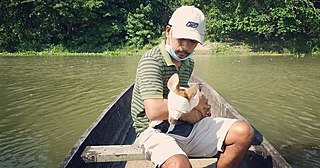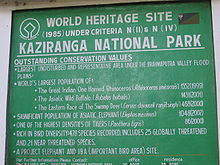
Kaziranga National Park is a national park in the Golaghat and Nagaon districts of the state of Assam, India. The park, which hosts two-thirds of the world's Indian rhinoceroses, is a UNESCO World Heritage Site. According to the census held in March 2018 which was jointly conducted by the Forest Department of the Government of Assam and some recognized wildlife NGOs, the rhino population in Kaziranga National Park is 2,613. It comprises 1,641 adult rhinos ; 387 sub-adults ; and 385 calves.

A rhinoceros, commonly abbreviated to rhino, is a member of any of the five extant species of odd-toed ungulates in the family Rhinocerotidae. Two of the extant species are native to Africa, and three to South and Southeast Asia.

The Indian rhinoceros, or Indian rhino for short, also known as the greater one-horned rhinoceros or great Indian rhinoceros, is a rhinoceros species native to the Indian subcontinent. It is listed as Vulnerable on the IUCN Red List, as populations are fragmented and restricted to less than 20,000 km2 (7,700 sq mi). Moreover, the extent and quality of the rhino's most important habitat, the alluvial Terai-Duar savanna and grasslands and riverine forest, is considered to be in decline due to human and livestock encroachment. As of August 2018, the global population was estimated to comprise 3,588 individuals, including 2,939 individuals in India and 649 in Nepal. Kaziranga National Park alone had an estimated population of 2,048 rhinos in 2009. Pobitora Wildlife Sanctuary in Assam has the highest density of Indian rhinos in the world with 84 individuals in an area of 38.80 km2 (14.98 sq mi) in 2009.

Jaldapara National Park is a national park situated at the foothills of the Eastern Himalayas in Alipurduar District of northern West Bengal, India, and on the banks of the Torsa River. Jaldapara is situated at an altitude of 61 m and is spread across 216.51 km2 (83.59 sq mi) of vast grassland with patches of riverine forests. It was declared a sanctuary in 1941 for protection of its great variety of flora and fauna.
Edward Pritchard Gee (1904–1968) was a Cambridge educated, Anglo-Indian tea-planter and an amateur naturalist in Assam, India. He is credited with the 1953 discovery of Gee's golden langur. He is notable as an early influential wildlife conservationist, especially for his 1959 and 1963 surveys and recommendations resulting in the creation of Chitwan National Park, the first of nine national parks in Nepal.

The barasingha, also known as the swamp deer, is a deer species distributed in the Indian subcontinent. Populations in northern and central India are fragmented, and two isolated populations occur in southwestern Nepal. It has been extirpated in Pakistan and Bangladesh, and its presence is uncertain in Bhutan.

The biodiversity of Assam, a state in North-East India, makes it a biological hotspot with many rare and endemic plant and animal species. The greatest success in recent years has been the conservation of the Indian rhinoceros at the Kaziranga National Park, but a rapid increase in human population in Assam threatens many plants and animals and their natural habitats.

Mary Victoria Curzon, Baroness Curzon of Kedleston, was a British peeress of American background who was Vicereine of India, as the wife of Lord Curzon of Kedleston, Viceroy of India. As Vicereine of India, she held the highest official title in the Indian Empire that a woman could hold.
The history of Kaziranga National Park in the Golaghat and Nagaon districts of the state of Assam, India, can be traced back to the beginning of the twentieth century, in 1904. It now is a World Heritage Site and hosts two-thirds of the world's Great One-horned Rhinoceroses, tigers, and many other endangered animals.
Kaziranga National Park in India has a good conservation history, especially due to its efficient management policies. In spite of the efficient conservation policies there are some loopholes in the conservation policies.

Kaziranga National Park is an Indian national park and an UNESCO World Heritage Site situated in the Golaghat and Nagaon district of Assam, India. It is a tourist destination and conservation area particularly notable as a refuge for the endangered Indian one-horned rhinoceros, hosting the largest population of wild Indian one-horned Rhinoceros in the world. The park contains significant stock of three other large herbivores — the Asian Elephant, the Asiatic Water Buffalo and the eastern subspecies of the Swamp Deer. Kaziranga also has the highest density of tiger in the world and is declared a Tiger Reserve in 2006. Kaziranga is recognized as an Important Bird Area by Birdlife International for conservation of avifaunal species.
Kaziranga National Park is an Indian national park and an UNESCO World Heritage Site situated in the Golaghat and Nagaon district of Assam, India. It is a tourist destination and conservation area particularly notable as a refuge for the endangered Indian one-horned rhinoceros, hosting the largest population of wild Indian one-horned Rhinoceros in the world. The park contains significant stock of three other large herbivores — the Asian Elephant, the Asiatic Water Buffalo and the eastern subspecies of the Swamp Deer. Kaziranga also has the highest density of tiger in the world and is declared a Tiger Reserve in 2006. Kaziranga is recognized as an Important Bird Area by Birdlife International for conservation of avifaunal species.
Kaziranga National Park is an Indian national park and a World Heritage Site in Golaghat and Nagaon districts of Assam, India. It is refuge for the world's largest population of Great One-horned Rhinoceros. Kaziranga has the highest density of tigers in the World. The park has many Elephant, Water Buffalo and Swamp Deer and is an Important Bird Area. The park has achieved notable progress in wildlife conservation despite several constraints.

Kaziranga National Park is an Indian national park and a World Heritage Site in Golaghat and Nagaon districts of Assam, India. It is refuge for the world's largest population of Great One-horned Rhinoceros. The park has many Elephant, Water Buffalo and Swamp Deer. It is recognized as an Important Bird Area by Birdlife International for conservation of avifaunal species. The park has achieved notable progress in wildlife conservation despite several constraints.
Kaziranga National Park is an Indian national park and a World Heritage Site in Golaghat and Nagaon districts of Assam, India. It is refuge for the world's largest population of great one-horned rhinoceros. Kaziranga has the highest density of tigers among protected areas in the world and was declared a Tiger Reserve in 2006. The park has large breeding populations of elephant, wild Asiatic water buffalo and swamp deer. Kaziranga is recognized as an Important Bird Area by Birdlife International for conservation of avifaunal species. The park has achieved notable progress in wildlife conservation with respect to other protected areas in India.Kaziranga was declared a Tiger Reserve in 2006

Rhino poaching in Assam is one of the major environmental issues in India which continues in the region of Kaziranga National Park, Manas National Park and some other grasslands of Assam. Indian rhinos inhabited most of the floodplain of the Indogangetic and Brahmaputra riverine tracts and the neighboring foothills.

The Northbrook Gate, was constructed to welcome British viceroy Lord Northbrook who visited Guwahati in 1874. The gate was built near Sukreswar Ghat where the viceroy anchored his ship. It is the only monument of its kind in this part of Assam and the lone surviving brick architecture from colonial times. For the last 140 years, it has remained a silent spectator of many developments of Guwahati.
The Brahmaputra floods refers to a catastrophic flood event that occurred in 2012 along the Brahmaputra River and its tributaries, as well as in subsequent years.

Manoj Gogoi is an Indian wildlife conservationist and wildlife rehabilitationist from Assam. He has rescued over 5000 Animals in Kaziranga National Park, a national park in the Golaghat, Karbi Anglong and Nagaon districts of the state of Assam, India. He is widely known for saving desperate animals from the annual Assam floods.












